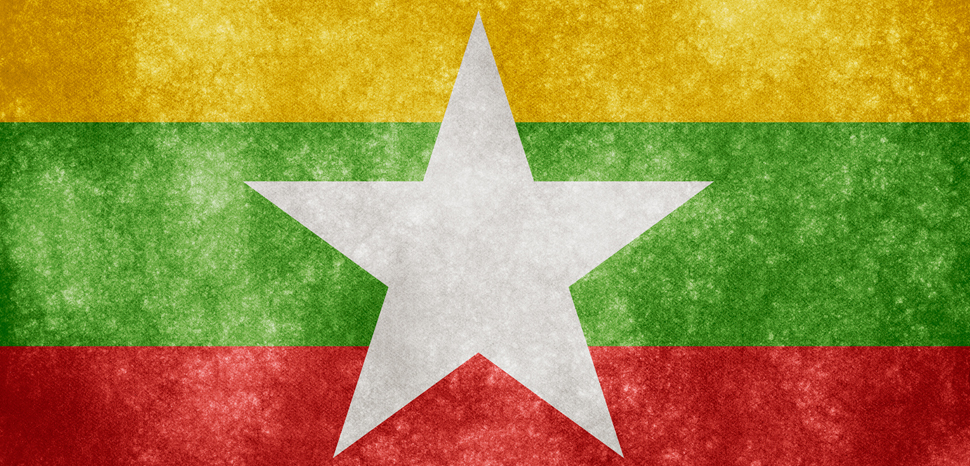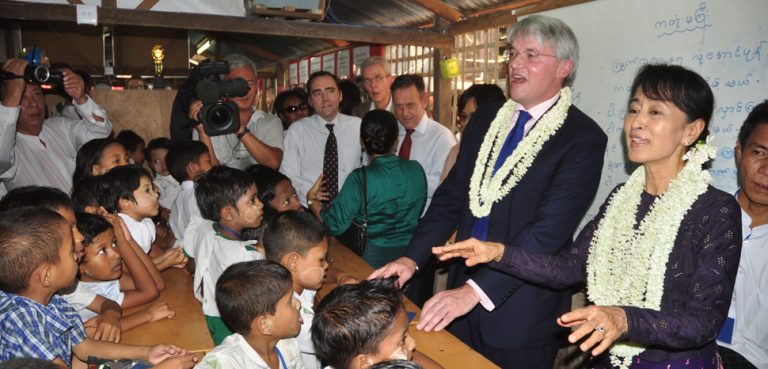In the northern part of Myanmar next to the Chinese border, there lies a Wa state where the way of life resembles that across the border in China. The yuan has become the main currency, Chinese language is widely spoken, and mobile telephones are connected to Chinese networks. It is also where the United Wa State Party (UWSA), the largest non-state armed group in the country, is located. This April marked the 30th anniversary of an internal coup within the Communist Party of Burma (CPB) by the Wa, with a three-day military parade. During the parade, Bao Youxiang, the President of Wa, even vowed, “We will not hesitate to sacrifice our lives and achieve the goal of being an autonomous state.”
This article will discuss the reasons behind such a phenomenon in Wa state, the way and the extent of China’s intervention, and also the challenges faced by the Myanmar government.
Historical background of Myanmar’s ethnic issues
After the Second World War, the interim Myanmar government organized a meeting between the Shan, Kachin and Chin ethnic minority leaders, along with Aung San, to make Myanmar an independent (from Britain) and united (multi-ethnic) country. They eventually reached the Panglong Agreement in 1947, which allowed Frontier Areas to have full internal autonomy.
However, several leaders that promoted Burma’s independence were assassinated within five months, including Aung San. Thereafter, U Nu, the successor of Aung San, applied a different approach toward ethnic issues. He suggested a solution to strengthen the consistency of the group rather than letting them build a separated state. In 1961, he reinstated Buddhism, the religion of the Bamar people, as the state religion. Such an act, however, pushed those ethnic groups further and provoked their anger due to its deviation from the Panglong Agreement. Hence, they equipped themselves and fought for their rights, and a conflict erupted. After several years of battle, the “Arms for Democracy” initiative offered amnesty for rebels and the number of insurgents declined significantly.
China’s intervention in Wa
Back in the 1950s, China was already present in the Wa region and its influence gradually prevailed. During the Chinese civil war, the Kuomintang forces were compelled to retreat to parts of the Wa mountains, especially after their failed effort to raid Yunnan and later their defeat. The Kuomintang’s presence was a vital reason why China decided to support the Communist Party of Burma (CPB) at that time. They united to identify the possible infiltration routes and survey the border, and old Kuomintang bases were some of the first targets. When CPB rebelled against the Myanmar government, China even offered military assistance, weapons and equipment to CPB between 1968 and 1979. For instance, the foot soldiers were mainly “volunteers” from China, and China’s provision of weapons made them the most formidable rebel army in Myanmar.
Even after the dissolution of the CPB, China’s influence still prevailed. In 1989, the CPB was broken down into four new ethnic armed organizations (EAOs), including the United Wa State Army (UWSA). The deputy chairman of the CPB and other central leaders were detained during the coup, and all of them were sent to Menglian County in China. It is believed that China played a role in this uprising and the whole CPB leadership was offered retirement in China. What China wanted to do was to pressure the communist leaders to step down. The main reason being that China didn’t intend to export revolutionary ideas to Myanmar anymore. Instead, due to the opening-up policies, China hoped to open the border trade with Myanmar to explore its rich resources.
The military government took this chance to offer a ceasefire agreement. It allowed the newly formed rebel groups to retain their land and army, but only in exchange for not fighting the government’s army. This led to the establishment the UWSA’s territory, including the acquisition of some lands of Khun Sa in 1996. Economically, Chinese companies also attained a foothold in the Wa area for agricultural production. A thousand hectares of rubber, lemon trees, oolong tea, and fruits were planted between 2009 and 2014. In May 2011, China also imported 12,000 tons of corn to deal with its domestic supply shortages, and Myanmar became one of the largest China’s corn supply substitute countries. Militarily, China quietly transferred weapons to the United Wa State Army (UWSA), such as heavy machine guns, armored fighting vehicles, artillery, as well as HN-5A ManPortable Air Defense Systems (MANPADS).
Not only China intervened in Wa state, but also the Myanmar government. China’s intervention toward the Myanmar government has also been increasing since the 1990s following its international isolation by the West. The post-Cold War international environment was not friendly to Myanmar’s military regime due to its crackdown on the democracy movement in 1988 by Myanmar’s military and the nullification of the 1990 election results. As a result, Myanmar’s military was condemned by the West through sanctions and the government has no choice but to engage closely with China. Therefore, Myanmar relied on support from the Chinese government, both economically and politically, and developed a friendly relationship with China. For example, China has constructed hydropower stations, as well as oil and gas pipelines from the deep-water port of Makassar Bay in Myanmar to Kunming, China.
The extent and reasons for China’s intervention
China would like to help Myanmar to solve its internal problems by holding talks and meetings with UWSA. For instance, in 2013, a Chinese special envoy served as the major point of contact and formal observer to Myanmar’s peace talks. Even in 2015, he remains crucial in facilitating talks between the ethnic armed groups and the Myanmar government. Meanwhile, a coordination meeting was held between the Ta’ang National Liberation Army (TNLA) and Shan State Army-South (SSA-S) over their territorial disputes. China supported UWSA’s endeavor to increase its leadership role among ethnic groups, hoping UNSW to be the central force to manage different ethnic minorities.
The reasons for the prevalence of China’s intervention are manifold. For one, it is in line with Beijing’s long-term strategic interests. “Border stability” is China’s focal policy objective in Myanmar, as the Wa state is located near to its border. Another critical point is the possibility and the intensity of the ethnic conflicts and their spillover to China’s side of the border. Therefore, China is worried about a similar incident that could happen in USWA. This would raise security concerns and dampen China’s infrastructural growth in this area. For example, Myanmar warplanes dropped bombs during MNDAA clashes with the military in 2015, hitting China’s side of the border and killing five Chinese citizens. This kind of incident could severely impact China’s infrastructural development in Myanmar, especially its construction of oil and gas pipelines.
Another motivation is China’s wish to play a leading role in Myanmar’s internal conflicts. China considers the ethnic minorities near the borderlands as a buffer against external threats. China would like to make use of its leadership role in the ethnic conflicts to show the Myanmar government that Beijing can help solve the country’s internal problems. China has also seen the erosion of some of its influence due to the involvement of the United States, which grew following sanctions being lifted in 2012. Thus, China would like to prevent Myanmar moving any closer to the US and protect its investment in the country.
Myanmar’s internal challenges
As time goes by, more conferences are called on to deal with the ethnic issues, and the most attentive one is the 21st Century Panglong Conference. According to state media, negotiators reached 37 out of 45 basic principles for discussions in the political, economic, social, land and environmental fields, under the principle of “federalism.” However, it was not agreed upon by the nationality representatives, since the process of the conference was dominated by the government, especially the Tatmadaw representatives. The Aung San Suu Kyi government had to acquire support from the military, due to the military’s longstanding power.
Thus, despite China’s prevalence and influence in the region, Myanmar still failed to address its internal ethnic problems, particularly the Wa state issue. The major problem is the great power long held by the Myanmar military. The 2008 constitution allocated a quarter of seats in parliament to the military and allows military candidates to be nominated for seats in both houses of the parliament. Moreover, it also enables the commander-in-chief, who is the ultimate military authority, to have the right to “take order and exercise state sovereign power.” All this exposes the fact that the constitution grants authority to the military, allowing them to overriding the authority of the president, thus safeguarding its own institutional position.
Conclusion
All in all, China was already present in the Wa state back in the 1960s in its support for the CPB and exporting of revolutionary ideas. Beijing’s intervention has been increasing since the 1990s, intent on maintaining regional peace and promoting economic growth. In some ways, a strong UWSA could give China a greater voice in helping Myanmar solve its internal ethnic problems. Yet it is not completely in China’s interest to see a stronger UWSA, as it brings the prospect of greater unrest near the border. Therefore, the Chinese government is trying its best to keep the whole situation in equilibrium. In terms of the future of Myanmar, Myanmar’s military still holds a large share of power and, in the face of complex ethnic issues, threatens to perpetuate a stalemate going forward.
The views expressed in this article are those of the authors alone and do not necessarily reflect those of Geopoliticalmonitor.com or any institutions with which the authors are associated.




